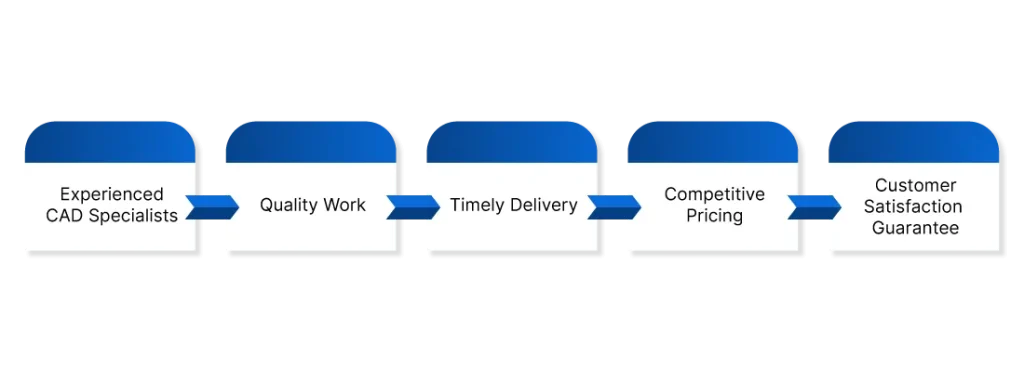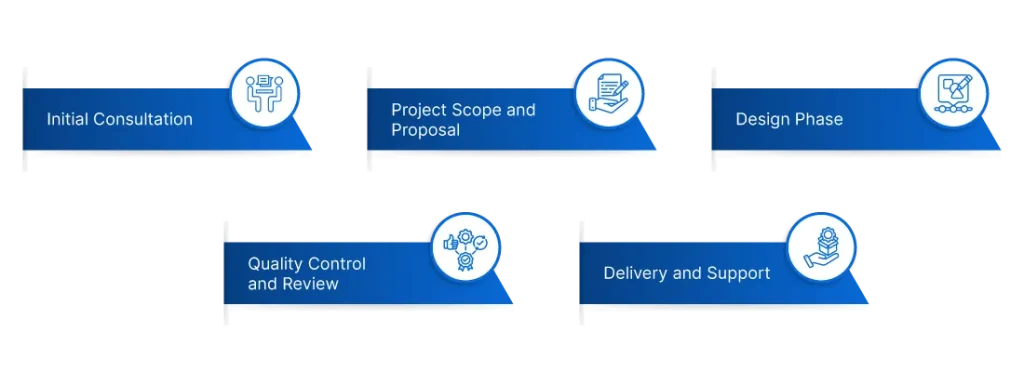Reverse Engineering CAD Engineering Services
Are you looking for high-quality and accurate 3D CAD design services for your next project? Look no further! Our team of experienced CAD specialists is here to help you bring your designs to life. We offer a wide range of CAD design services, including 3D modeling, 2D drafting, conversion, and migration services. Our CAD design process is transparent, efficient, and collaborative. We work closely with our clients to understand their requirements, and we provide regular updates throughout the design process to ensure that the final designs meet their expectations. Our process includes an initial consultation, project scope and proposal, design phase, quality control and review, and delivery and support. With our CAD design services, we can assure you of working with experienced CAD specialists who deliver quality work on time and at a competitive price.
Our CAD specialists have extensive experience in building 3D models, ranging from simple designs to complex assemblies, using a variety of software tools such as NX, Solid Edge, SolidWorks, Creo, Autodesk Inventor, CATIA, and more. We work closely with our clients to understand their requirements and provide accurate 3D models that meet their needs.
We understand the importance of accurate 2D drafting in the CAD design process, and we offer drafting services that cover all your needs. Our drafting services include converting your paper drawings and blueprints to digital formats, creating 2D drawings from 3D models, and drafting services for files from other CAD software platforms. We use industry-standard software tools such as AutoCAD and SolidWorks to create accurate and unambiguous 2D drawings that convey all the required information to the manufacturer.
We understand that many companies have legacy data in various file formats, and we offer conversion and migration services to help you move your data to a more modern platform. Our conversion and migration services can cover all your paper drawings, blueprints, and even files from other CAD software platforms. We can convert files to and from various formats, ensuring that you can work with your data in the software tools of your choice. We also offer additional services such as rendering and simulation, product design and development, reverse engineering, and more. Our team of CAD specialists has extensive experience in a wide range of industries, including aerospace, automotive, consumer products, and medical devices, among others. We pride ourselves on providing quality work, timely delivery, and competitive pricing to ensure customer satisfaction.
Conversion of 2D drawings to 3D model in STEP/IGES




Professionalism and work ethics… "The level of professionalism and work ethic you bring to the table is simply great. The fact that clicked the most is when you took complete responsibility for our product development and the outcome is exactly what we desired. Thank you Prescient."

First on our list, without doubt … “I greatly appreciate the software development work you have been doing for Level 3 Inspection for all these years. Your team’s skills and your methodical approach to perfection, coupled with your high level of professionalism, have made the road pretty smooth for us to achieve our organizational and operational integration goals. If we have to recommend a competent partner we can totally depend on, your name would be the first on our list, without a doubt. Thank you Prescient!”

They are the exception... "We've been working with Prescient Technologies for quite a few years now, and they continue to provide quality work in a timely manner for a reasonable cost. They are the exception to the two out of three rule! (Fast, High Quality or Good Price, pick two)"

There could not have been a better alternative… "It was a chance meeting with the Prescient team that set the ball rolling. Initially I was skeptical but their attitude “Together we can” inspired confidence. ”Hand-holding” by Prescient was exemplary and that was crucial for a start-up like ours. Our project in Orthopaedic navigation involved totally new objectives in as yet unexplored areas to be achieved with innovative steps in CAD domain. Few years down the line together we have added a chapter at the very edge of scientific knowledge. Thanks to Prescient our software idea has now evolved into a full-fledged market-ready product. Today I am convinced that there could not have been a better alternative."

Professionalism and work ethics… "The level of professionalism and work ethic you bring to the table is simply great. The fact that clicked the most is when you took complete responsibility for our product development and the outcome is exactly what we desired. Thank you Prescient."
Our CAD design services are suitable for a wide range of industries, including manufacturing, automotive, aerospace, defense, architecture, and many others. We have experience in creating 3D models and 2D drawings for various products, components, and systems.
Our team of CAD specialists has expertise in using a variety of software tools, including NX, Solid Edge, SolidWorks, Creo, Autodesk Inventor, CATIA, and more. We can work with the software tools of your choice.
Yes, we offer conversion and migration services that can cover all your paper drawings, blueprints, and even files from other CAD software platforms. We can convert your paper drawings or blueprints into 3D models and 2D drawings that are accurate and high quality.
The timeline for a CAD design project depends on the complexity of the project, the scope of work, and the number of revisions required. We will provide you with a timeline estimate during the initial consultation phase.
Yes, we encourage our clients to provide feedback and request changes or revisions to the designs throughout the design process. We will work closely with you to ensure that the final designs meet your requirements and expectations.
We have a rigorous quality control and review process that includes multiple checks and tests to ensure the accuracy and quality of the CAD designs. Our team of CAD specialists also has extensive experience in creating 3D models and 2D drawings that are precise and reliable.
Yes, we offer CAD design services for both prototypes and small production runs. Our team can work with you to design and create 3D models and 2D drawings that are optimized for manufacturing and production.
Yes, we are committed to protecting the confidentiality and intellectual property of our clients. We are happy to sign an NDA or any other legal agreements that are required to ensure the protection of your information and designs.
We can deliver the final CAD designs in a variety of file formats, including IGES, STEP, STL, PDF, and others. We will work with you to determine the best file format for your specific needs and requirements.
In today’s competitive U.S. manufacturing landscape, managing product data and engineering processes efficiently is critical. Many companies recognize the need for Product Lifecycle Management (PLM) systems. But choosing PLM Teamcenter Implementation Services is just the start. The real challenge lies in executing it effectively. Here’s what you need to know to get your Teamcenter implementation right and avoid costly mistakes. Why Teamcenter Implementation Matters Teamcenter by Siemens is one of the most widely used PLM platforms across American manufacturing companies. It streamlines collaboration, centralizes data, and supports the entire product lifecycle from concept to disposal. When implemented properly, Teamcenter can: But not all implementations deliver these results. Success depends on careful planning, clear communication, and expert execution. What Challenges Are U.S. Manufacturers Facing? Most U.S. manufacturers deal with data silos, outdated systems, and process inconsistencies. Without a strong PLM foundation, these issues can impact product quality, team productivity, and customer satisfaction. Ask yourself: Recognizing these issues helps you align your implementation goals with real business value. 7 Best Practices for Successful PLM Teamcenter Implementation 1. Define Business Goals Early Start with a clear purpose. What specific results do you expect from the system? These might include reducing engineering change time, automating approval workflows, or improving supply chain visibility. Clear goals help your PLM Teamcenter Implementation Services partner configure the solution to meet your needs. 2. Involve Stakeholders From Day One Bring in voices from every department engineering, quality, purchasing, IT, and operations. This creates ownership, ensures system usability, and reduces resistance to change. Stakeholders can also identify custom features they need from Teamcenter customization services. 3. Keep Initial Deployment Focused Avoid the temptation to roll out everything at once. Begin with core features like: This reduces complexity and gives users confidence with the new system before expanding. 4. Choose the Best Partner, Not Just the Cheapest Implementation is not just a technical job it’s a business transformation. Work with a provider who understands both Teamcenter and U.S. manufacturing challenges. When you choose the best partner, look for: 5. Clean and Prepare Your Data Poor data can break even the best PLM system. Legacy data must be cleaned, structured, and validated before migration. Involve experienced data engineers to: Start this process early, so your implementation stays on track. 6. Train Users and Manage Change Actively Many implementations fail due to poor user adoption. Avoid this by providing: Explain how the system helps users in their day-to-day work. When people understand the “why,” adoption improves. 7. Measure, Learn, and Iterate Track KPIs like cycle time reduction, fewer ECO delays, or improved collaboration. Use real data to identify what’s working and what needs adjustment. PLM isn’t a one-time project. It’s a continuous process that grows with your business. U.S. Trends: Why This Matters Now According to TechCrunch, the U.S. is seeing rapid PLM adoption in the automotive, aerospace, and industrial equipment sectors (2024). Companies are prioritizing modular rollouts and cloud-native solutions to reduce time and cost. Lucent Innovation also reports that PLM integrations with ERP and MES systems are becoming a standard practice among U.S. manufacturers looking for end-to-end visibility. Key Takeaways Let’s Make Your PLM Journey a Success If you’re looking to reduce product delays, increase engineering efficiency, or improve data visibility, Prescient Technologies can help. We offer tailored PLM Teamcenter Implementation Services for U.S.-based manufacturers, with industry-proven expertise in configuration, customization, and user onboarding. 👉 Talk to our experts to choose the best path for your PLM success. Contact Us Prescient Technologies has supported global manufacturers since 2000. Our offerings include Teamcenter customization services, digital factory solutions like factoryCONNECT, machineCONNECT, and powerCONNECT, and legacy modernization. Let us help you simplify your product lifecycle and focus on innovation.
Read MoreWhy PLM Connectors Matter More Than Ever Have you ever struggled with scattered product data, duplicate files, or endless switching between design and enterprise systems? You’re not alone. U.S. manufacturers are increasingly looking for smarter ways to connect siloed systems and PLM connectors are at the heart of that shift. According to the National Association of Manufacturers, 94.6% of U.S. manufacturing leaders view digital transformation as critical for competitiveness in 2025. That’s where PLM connectors can change the game. They help your CAD, ERP, and MES systems speak the same language removing delays, reducing rework, and helping teams collaborate better. If you’re looking to digitally upgrade your manufacturing operations in the USA, finding the right connector is essential. What PLM Connectors Actually Do PLM connectors allow seamless data exchange between disconnected systems. This reduces manual input, avoids errors, and improves productivity. Whether you’re handling complex assemblies or working on version control, these connectors help maintain a single source of truth for your teams. In the U.S., where sectors like aerospace, defense, and medical devices demand strict traceability and compliance, reliable PLM integration is not just helpful it’s essential. A TechCrunch report from late 2023 revealed that businesses adopting integrated PLM platforms saw a 35% decrease in product launch delays and a 28% cut in engineering overhead. Core Features to Look for in PLM Connectors When evaluating PLM integration connectors, don’t just settle for compatibility. Focus on these core features: 1. Bidirectional Data Sync Essential for U.S. manufacturers managing data-intensive environments. The connector should allow real-time two-way sync between systems like PTC Windchill and Oracle ERP. 2. CAD Compatibility Whether you’re using AutoCAD, SOLIDWORKS, or Creo your connector must be CAD-aware. This is especially critical in sectors like aerospace and automotive, where design accuracy matters. 3. Real-Time Collaboration Support Teams across cities, states, or suppliers need access to up-to-date design data. Real-time syncing ensures this especially when working with distributed teams in Detroit, Texas, or Silicon Valley. 4. Robust Security and Access Control U.S. businesses often deal with sensitive intellectual property. Your connector must support AES encryption, role-based access, and SOC 2-level data handling. 5. Error Handling & Data Validation The connector should alert users to sync failures or data mismatches. This is key in regulated industries like medical device manufacturing, where quality audits are routine. 6. Custom Workflow Support No two U.S. factories run the same process. Your connector must allow you to customize workflows, approval steps, and version control as per your SOPs. Choosing the Best: What USA-Based Manufacturers Should Consider In the U.S., smart manufacturing is being boosted by federal initiatives like the CHIPS and Science Act and the Advanced Manufacturing National Program Office (AMNPO). To align with this push, your PLM connector should support: ✔ Compliance with U.S. Standards Look for connectors that help you meet FDA 21 CFR Part 11, AS9100, or ITAR compliance, depending on your industry. ✔ Support for Cloud & On-Premise Systems Many U.S. mid-sized manufacturers still run legacy systems. A hybrid-compatible connector that works with both SaaS PLM and on-premise ERP is ideal. ✔ MES & ERP Integration For companies using SAP, Oracle, or factoryCONNECT, your connector should enable data flow from design to shop floor, with full traceability. ✔ Localised Vendor Support Choosing a vendor that offers U.S.-based support, regular updates, and timezone-aligned assistance ensures fewer disruptions. “Integration is no longer optional it’s foundational,” says Ron Miller, tech journalist (TechCrunch). “Companies that treat data as a connected asset build stronger, faster workflows.” Is It Time to Switch Your Connector? Ask yourself: If yes, it’s time to choose the best PLM integration connector one that’s built for how U.S. manufacturers actually operate. Why Choose Prescient Technologies’ PLM Connectors Prescient Technologies designs custom PLM connectors tailored for U.S. manufacturing challenges. Whether you’re in aerospace, medical devices, or heavy machinery, our connectors bridge the gap between design, operations, and compliance. We support: Key Takeaways 🇺🇸 Let’s Connect: U.S.-Ready PLM Integration Solutions Looking for a PLM connector built with U.S. manufacturing in mind?Prescient Technologies delivers integrations that are secure, flexible, and compliance-ready backed by teams who understand your industry and time zone. 👉 Talk to us now to explore PLM connector solutions that work across your CAD, ERP, and MES systems in the USA.
Read MoreIn the highly competitive U.S. manufacturing sector, being first to market, maintaining product quality, and controlling costs aren’t just goals they’re survival. Legacy systems, fragmented processes, and versioned product data often stand between you and operational excellence. If you’ve felt the drag of disconnected tools or dreaded a change order breakdown, it’s time to see Product Lifecycle Management (PLM) software as more than a buzzword. Paired with modernization and customization, it becomes a powerful engine for growth. In this article, you’ll learn: Attention: The Cost of Staying Disconnected Many U.S. manufacturers operate with legacy systems or siloed tools CAD, ERP, spreadsheets, homegrown apps each managing a slice of your product data. The consequences are familiar: This disjointed state may mask itself as “just how we operate,” but its real cost is lost agility, wasted effort, and risk. With global competition, supply chain volatility, and accelerating customer demands, you can’t afford delays or discrepancies. That’s where PLM opens a new horizon especially when done right for U.S. manufacturing contexts. Interest: What PLM Actually Does for You Understanding PLM Product Lifecycle Management (PLM) software weaves together people, processes, and data across the entire life of a product from concept through engineering, manufacturing, service, and retirement. It becomes a single source of truth for product data across your enterprise. Wikipedia+2Fortune Business Insights+2 In the U.S., many manufacturers are turning to cloud-ready PLM stacks (often hosted on AWS or Azure), benefiting from scalability, performance improvements, and integrations with IoT, analytics, and digital twin systems. Amazon Web Services, Inc. Key Benefits That US Manufacturers Realize Benefit What You Gain Supporting Insight / Stat Faster time-to-market Product changes, approvals, BOM updates flow faster PLM solutions on AWS help reduce development cost and eliminate data silos. Amazon Web Services, Inc. Reduced cost and waste Less rework, fewer errors, fewer manual interventions End-to-end PLM can reduce defects by up to 50%. Frigate Improved collaboration + consistency Engineering, supply, quality, service all work from synced data PLM eliminates silos and improves decision-making. TriMech Enterprise+1 Better quality & traceability Track parts, versions, and history; manage audits PLM supports compliance, traceability, and regulatory oversight. TriMech Enterprise Scalability & innovation Use analytics, digital twins, and variants management The PLM market is expected to grow strongly; North America leads adoption. Grand View Research+1 In fact, North America accounted for ~35 % of the PLM market share in recent years. Grand View Research+1 The growth curve means more competitors, smarter startups, and rising expectations which makes modernization not optional but imperative. Desire: Bridging the Gap From Legacy to Next-Gen PLM “In theory, PLM is great but our systems are old, custom, fragile.” If that’s you, you’re not alone. Many U.S. manufacturers hesitate because replacing legacy systems is risky. The smarter path is modernization + extension. Here are three pillars you must integrate into your PLM journey: 1. Legacy Application Modernization Services Modernizing legacy systems is your foundation. Whether your prior PLM, ERP modules, supply chain tools, or custom utilities are brittle, poorly documented, or monolithic modernizing them is crucial. Refactor, decouple, migrate to modern platforms, remove technical debt, and open up APIs. A modern backbone ensures that your PLM doesn’t just overlay complexity it becomes sustainable, maintainable, and extensible. 2. Product Configurator Software Many U.S. manufacturers (especially those in discrete, industrial, medical, or automotive segments) deal with product variants, custom options, and configurable lines. A product configurator software tied into PLM allows: This means fewer errors, faster quotes, and better alignment between design and production. 3. Application Development Services Out-of-box PLM often doesn’t directly match every business rule or niche workflow. You may need: With robust Application Development Services, you tailor your PLM to your unique U.S. operations not force your operations to bend to a tool. A Suggested Roadmap for U.S. Implementation Here’s a phased approach that many U.S. manufacturers follow: If done well, some manufacturers see ROI in months by reducing rework, speeding time-to-market, and improving first-pass yields. Action: Why Prescient Technologies Should Be Your PLM Partner At Prescient Technologies, we specialize in guiding U.S. manufacturers through the full PLM transformation journey. What sets us apart: We believe in a practical, phased approach rather than an all-or-nothing rollout. Our team works hand-in-hand with your engineering, IT, and operations functions to ensure adoption, minimize risk, and deliver long-term value. Ready to explore how PLM + modernization could transform your product lifecycle? Contact Prescient Technologies today for a discovery session. We’ll assess your current state, outline your roadmap, and help you take the first step toward a modern, data-driven manufacturing future.
Read More